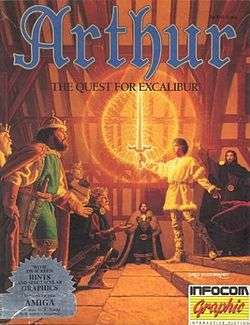Arthur: The Quest for Excalibur
| Arthur: The Quest for Excalibur | |
|---|---|
 | |
| Developer(s) | Challenge, Inc.[1] |
| Publisher(s) | Infocom |
| Designer(s) | Bob Bates |
| Artist(s) | Darrell Myers, Tanya Isaacson, Sophie Green, Donna Dennison, Jim Sullivan |
| Engine | ZIL |
| Platform(s) | Amiga, Apple II, MS-DOS, Macintosh |
| Release date(s) |
Macintosh/Amiga: June 6, 1989 Apple II: June 22, 1989 MS-DOS: July 14, 1989 |
| Genre(s) | Interactive fiction |
| Mode(s) | Single-player |
Arthur: The Quest for Excalibur is an illustrated interactive fiction computer game written by Bob Bates and published by Infocom in 1989. Typically for an Infocom title, it was released for many popular computer platforms of the time, such as the Macintosh, PC, and the Apple II series. Quite atypically for an Infocom product, it featured illustrations of locations, characters and objects within the game. It is Infocom's thirty-fourth game and is the second of two Infocom games developed by Challenge, Inc. using Infocom's development tools.[1]
Plot
The player assumes the role of a young Arthur, before the legendary days of Camelot. The "sword in the stone" (which in the legends was not Excalibur, but is often confused with Excalibur by people unfamiliar with the legends) that would signify Arthur's destiny to rule, has been stolen by the evil King Lot. In the quest to regain the sword, the player must prove to Merlin that he has the qualities needed to be a great king: chivalry, experience, and wisdom. Merlin assists Arthur by giving him periodic advice as well as the power to transform into animals, but also tells Arthur that unless Excalibur is recovered within three days, Lot will usurp his destiny as a king of legendary stature.
Feelies
Although Arthur was one of the last interactive fiction games Infocom released before closing, the packaging still included a modest attempt at the extra objects, or feelies, that had been a long-standing tradition for the company. The package for Arthur contained a copy of a Book of Hours, which explains the Canonical hours such as Matins, Lauds and Vespers. The book also contains a poem, lines of which are used as passwords in the game as a form of copy protection.
Production
Arthur: The Quest for Excalibur was the second Infocom game to be developed by another company, Challenge Inc, published by Infocom in their "Immortal Legends" genre.[1] The only other game published in this line was the 1987 release Sherlock: The Riddle of the Crown Jewels, also written by Bates. By the time of Arthur's release, Infocom had stopped rating their games in terms of difficulty. Arthur roughly corresponds to the level of their previous "Standard" games.
Reception
Computer Gaming World called Arthur "Infocom's most poorly produced game ever", criticizing the high number of disk swaps—sometimes to print a single sentence or to redraw the automap—and the "mediocre" Apple II graphics.[2]
References
- 1 2 3 Extending Experiences: Structure, Analysis and Design of Computer Game by Olli Leino, Hanna Wirman, Amyris Fernandez
- ↑ Scorpia (September 1989). "Scorpion's Tale" (PDF). Computer Gaming World. No. 63. p. 40. Retrieved 17 April 2016.
External links
- Arthur: The Quest for Excalibur at MobyGames
- Arthur: The Quest for Excalibur can be played for free in the browser at the Internet Archive
- Arthur information and overview
- Gallery of package and feelies for Arthur
- The Infocom Bugs List entry on Arthur